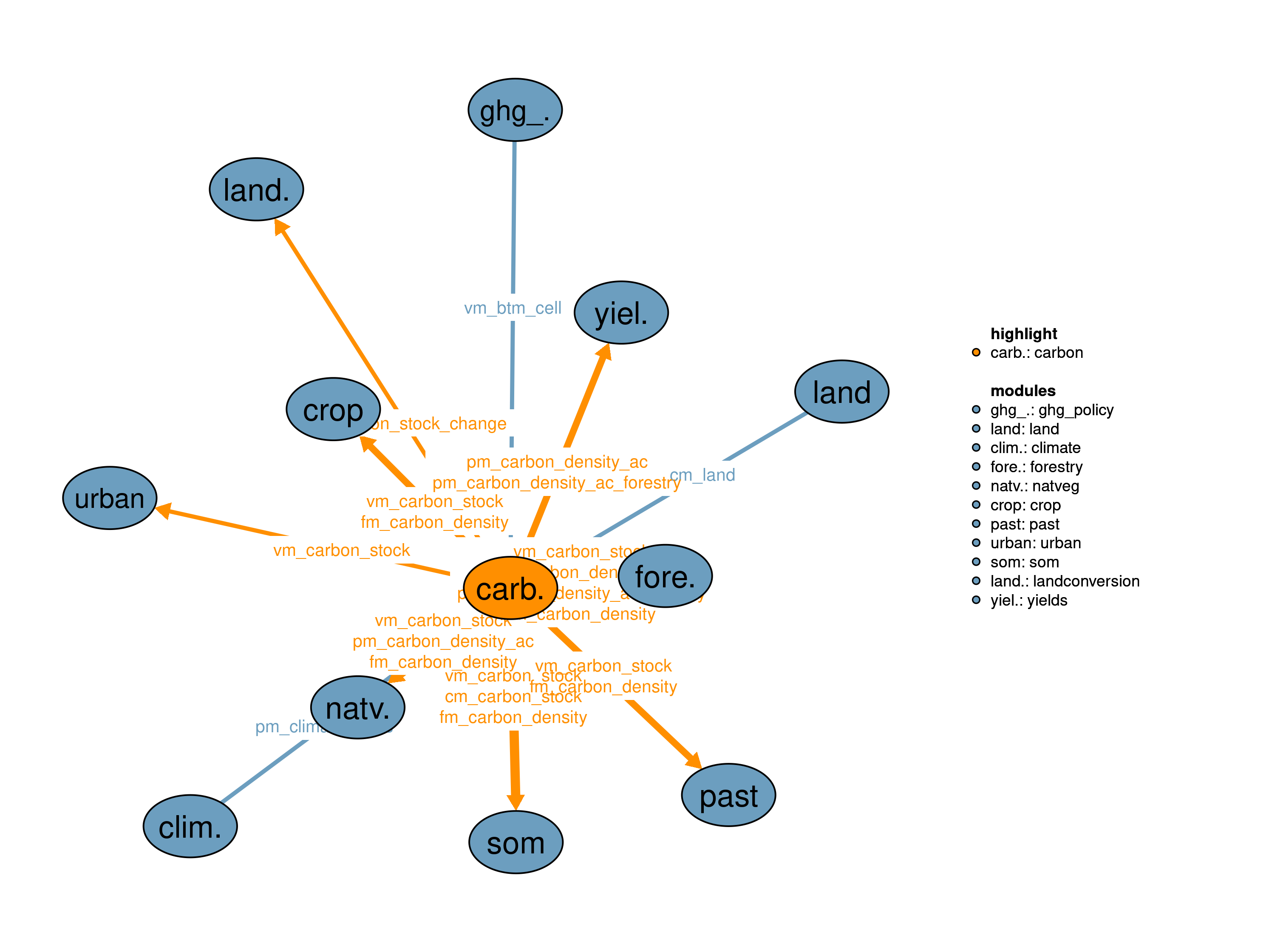The carbon module provides annual land-related CO2 emissions for the 56_ghg_policy module. The carbon module provides carbon density information on cellular level to all land modules (30_crop, 31_past, 32_forestry, 34_urban and 35_natveg), and in return it gets the current carbon stock levels from respective land pools. The module also accounts for changes in terrestrial carbon stocks cause by climate change effects on biosphere 45_climate.

| Description | Unit | A | B | |
|---|---|---|---|---|
| pcm_land (j, land) |
Land area in previous time step | \(10^6 ha\) | x | |
| pm_climate_class (j, clcl) |
Koeppen-Geiger climate classification on the simulation cluster level | \(1\) | x | |
| vm_btm_cell (j, emis_source, pollutants) |
Cellular emissions before technical mitigation | \(Tg/yr\) | x | x |
| Description | Unit | |
|---|---|---|
| fm_carbon_density (t_all, j, land, c_pools) |
LPJmL carbon density for land and carbon pools | \(tC/ha\) |
| pcm_carbon_stock (j, land, c_pools) |
Current carbon in vegetation soil and litter for different land types | \(10^6 tC\) |
| pm_carbon_density_ac (t_all, j, ac, ag_pools) |
Above ground natveg carbon density for age classes and carbon pools | \(tC/ha\) |
| pm_carbon_density_ac_forestry (t_all, j, ac, ag_pools) |
Above ground plantation carbon density for age classes and carbon pools | \(tC/ha\) |
| vm_carbon_stock (j, land, c_pools) |
Carbon stock in vegetation soil and litter for different land types | \(10^6 tC\) |
| vm_carbon_stock_change (j, land, c_pools) |
Change in carbon stocks compared to previous time step | \(10^6 tC/time step\) |
This realization calculates annual land-related CO2 emissions as difference of carbon stocks between the current and the previous time step. Land-related CO2 emissions include CO2 emissions from land-use change as well as changes in carbon stocks in the terrestrial biosphere due to climate change (the later is only included if c52_carbon_scenario = "cc"). The realization provides carbon density information on cellular level to all land modules (30_crop, 31_past, 32_forestry, 34_urban and 35_natveg), which return land type specific carbon stocks to the carbon module. The realization also provides carbon density for different age-classes, based on a chapman-richards volume growth model, to the land modules 32_forestry and 35_natveg (Humpenöder et al. 2014, and @braakhekke_modelling_2019).
Change of carbon stocks is calculated as a difference between the current and the previous time step.
\[\begin{multline*} vm\_carbon\_stock\_change(j2,land,c\_pools) = pcm\_carbon\_stock(j2,land,c\_pools) - vm\_carbon\_stock(j2,land,c\_pools) \end{multline*}\]
Annual CO2 emissions are obtained by dividing vm_carbon_stock_change by time step length (e.g. 5 or 10 years).
\[\begin{multline*} vm\_btm\_cell(j2,emis\_co2,"co2\_c") = \sum_{emis\_land(emis\_co2,land,c\_pools)}\left(\frac{ vm\_carbon\_stock\_change(j2,land,c\_pools)}{m\_timestep\_length}\right) \end{multline*}\]
Limitations CO2 emissions in the 1st time step (1995) are not meaningful because carbon stock information prior to 1995 is not available
In this realization annual land-related CO2 emissions are assumed zero.
Limitations CO2 emissions are assumed zero
| Description | Unit | A | B | |
|---|---|---|---|---|
| f52_growth_par (clcl, chap_par, forest_type) |
Parameters for chapman-richards equation | \(1\) | x | |
| pc52_carbon_density_start (t_all, j, ag_pools) |
Above ground carbon density for new land in other land pool | \(tC/ha\) | x | |
| q52_carbon_stock_change (j, land, c_pools) |
Calculation carbon stock reduction | \(10^6 tC/time step\) | x | |
| q52_co2c_emis (j, emis_co2) |
Calculation of annual CO2 emissions | \(10^6 tC/yr\) | x |
| description | |
|---|---|
| ac | Age classes |
| ag_pools(c_pools) | Above ground carbon pools |
| age | Population age groups |
| c_pools | Carbon pools |
| chap_par | Chapman-richards parameters |
| clcl | climate classification types |
| emis_co2(emis_source_cell) | Land pool CO2 emission sources |
| emis_land(emis_co2, land, c_pools) | Mapping between land and carbon pools |
| emis_source | Emission sources |
| forest_type | forest type |
| j | number of LPJ cells |
| j2(j) | Spatial Clusters (dynamic set) |
| k(kall) | Primary products |
| land | Land pools |
| pollutants(pollutants_all) | subset of pollutants_all that can be taxed |
| t_all(t_ext) | 5-year time periods |
| t(t_all) | Simulated time periods |
| type | GAMS variable attribute used for the output |
Benjamin Leon Bodirsky, Florian Humpenoeder, Abhijeet Mishra
10_land, 14_yields, 30_crop, 31_past, 32_forestry, 34_urban, 35_natveg, 39_landconversion, 45_climate, 56_ghg_policy, 59_som
Braakhekke, Maarten C., Jonathan C. Doelman, Peter Baas, Christoph Müller, Sibyll Schaphoff, Elke Stehfest, and Detlef P. van Vuuren. 2019. “Modelling Forest Plantations for Carbon Uptake with the LPJmL Dynamic Global Vegetation Model.” Earth System Dynamics Discussions, April, 1–24. https://doi.org/https://doi.org/10.5194/esd-2019-13.
Humpenöder, Florian, Alexander Popp, Jan Philip Dietrich, David Klein, Hermann Lotze-Campen, Markus Bonsch, Benjamin Leon Bodirsky, Isabelle Weindl, Miodrag Stevanovic, and Christoph Müller. 2014. “Investigating Afforestation and Bioenergy CCS as Climate Change Mitigation Strategies.” Environmental Research Letters 9 (6): 064029. https://doi.org/10.1088/1748-9326/9/6/064029.